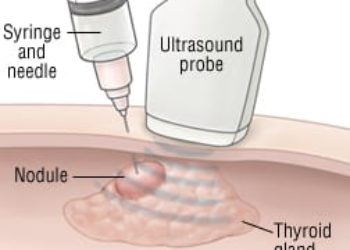Trends in thyroid cancer incidence and mortality in the United States from 1974-2013
1. This ecological study found that from 1974 to 2013, there were average annual increases in incidence rates and mortality rates in patients diagnosed with thyroid cancer.
Evidence Rating Level: 2 (Good)
Study Rundown: Thyroid cancer incidence rates have more than doubled between 1975 and 2013, with papillary cancer—the most common and least aggressive type—accounting for most of the increase. It is thus important to understand whether this increased incidence is due to greater risks among the general population or technical advances that have enabled for detection of smaller, more indolent cases. This ecological, population-based study addressed this question by evaluating SEER data from 1974-2013. It found that papillary thyroid cancer was the most common histologic type, and that thyroid cancer incidence increased, on average by 3.6% per year, primarily related to increases in PTC. Incidence mortality rates, as well as advanced stage PTC incidence rates also increased annually during the study period.
This study is significant in that it is the first to describe trends in thyroid cancer incidence and mortality in the US by demographic factors. Some limitations include its descriptive nature, individual-level environmental exposures, lifestyle factors, and inconsistent methods of thyroid cancer detection. Overall, the annual increase in thyroid cancer incidence rate and mortality suggests that a true increase of thyroid cancer is occurring.
Click to read the study, published in JAMA
Relevant Reading: Changing Trends in the Incidence of Thyroid Cancer in the United States.
In-Depth [ecological study]: This population-based ecological study evaluated the trends in thyroid cancer incidence rates and mortality based on patient demographic and tumor characteristics. Thyroid cancer cases were obtained from incidence files maintained by the National Cancer Institute, which included roughly 10% of the US population in SEER-9 areas (California [San Francisco and Oakland], Connecticut, Georgia [Atlanta only], Hawaii, Iowa, Michigan [Detroit only], New Mexico, Utah, and Washington [Seattle and Puget Sound region]) – demographic and cancer diagnosis information was available for each case. Information regarding the deaths of these patients from thyroid cancer were derived from information on death certificates extracted from the National Centre for Health Statistics.
In the study, a total of 77 276 thyroid cancer cases were diagnosed among residents of the SEER-9 areas. Thyroid cancer incidence rates increased over the study period, from 4.56 (95%CI 4.40 to 4.73) per 100,000 person-years in 1974-1977 to 14.42 (95%CI 14.20 to 14.64) per 100,000 person-years in 2010-2013, with the overall annual increase being 3.6% (95%CI 3.2% to 3.9%) per year, on average. Thyroid cancer incidence rates increased for all sex, race, and age groups. In regards to the tumor characteristics, significant increases were observed for PTC (annual percentage change, 4.4%, 95%CI 4.0% to 4.7%), follicular thyroid cancer (annual percentage change, 0.6%, 95%CI 0.2% to 0.8%), and medullary thyroid cancer (annual percentage change, 0.7%, 95%CI 0.2% to 1.1%). PTC incidence increased significantly for every stage and tumor size category. Thyroid cancer incidence-based mortality increased, on average, 1.1% (95%CI 0.6% to 1.6%) annually during 1994-2013, from 0.40 (95%CI 0.36 to 0.44) per 100,000 person-years in 1994-1997 to 0.46 (95%CI 0.43 to 0.50) per 100,000 person-years in 2010-2013.
Image: PD
©2017 2 Minute Medicine, Inc. All rights reserved. No works may be reproduced without expressed written consent from 2 Minute Medicine, Inc. Inquire about licensing here. No article should be construed as medical advice and is not intended as such by the authors or by 2 Minute Medicine, Inc.






